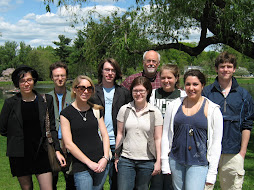
Chris Woodside (Photo by Dora Wilkenfeld)
By Rafal Wilson and Gregory Hebert
Christine Woodside, a veteran journalist, freelance reporter, and editor of two magazines, knows where print journalism has been—and she knows that it’s doomed if it doesn’t figure out how to make an effective movement to the web.
“The Internet is the new publishing house,” Woodside said, referring to how more and more publications in recent years have been moving to or premiering online. The problem with this, Woodside said, is that the Internet remains relatively untested ground for newspapers and other reporting institutions, which has not helped the revenue difficulties that they have been facing recently.
Woodside maintained that this has moved the industry into an experimental period at a time when there is little room for error, which explains why newspapers have not been weathering the current economic recession very well.
The main problem, she said, is that journals and newspapers simply do not yet know how to make money off of the Internet. The newspaper base is far more established, with most revenue coming from selling ads.
Readers have been moving to online sources partly because newspapers have been giving their product – news – away for free. Also, some newspapers simply refer their customer base to their websites instead of focusing on producing a good story. “The newspapers need to stop holding the surrender flag to the masses,” said Woodside.
Woodside does fear that with the current generation of readers receiving its news on the Internet that many readers would simply go elsewhere if they were asked to pay for a subscription.
As a result, Woodside believes that the industry will increasingly rely on non-profit enterprises funded through grants and other previously unthought-of means.
Woodside also believes that reporters and journalism is becoming increasingly specialized. She said that she foresaw a decrease in general reporters as new hires to the industry pick up on specific beats and stick with them throughout their careers.
Woodside has 18 years of experience in newspaper writing and has been reporting on the environment for 12 years. Her book, “The Homeowners Guide to Energy Independence,” is dedicated to helping ordinary people move away from fossil fuels in realistic ways.
Today, she serves as the editor to two environmental magazines, the Appalachian Journal and Connecticut Woodlands. “We try to get into the heads of people on trails and rivers,” Woodside said of the former, which is a collection of stories and essays about nature.
Woodside said that her passion for environmental reporting began at the age of 28, when she and her husband quit their jobs and hiked the Appalachian Trail. The trip, which took four and a half months and stretched from Georgia to Maine, deeply affected her.
According to Woodside, at the beginning of the trip it took three aspirin a night to fall asleep and there were some crying fits too. “I had to work with my wimp-osity,” she said.
However, the trip gave her a greater appreciation of the conveniences of modern life and the importance of the world around her. “By the end of the trip,” she said, “I viewed everything from my reporting to the water coming out of my kitchen faucet in a completely new light.”

Thanks to the class for making me sound so smart. One correction: the journal is called Appalachia.
ReplyDeleteWarmly, Chris Woodside